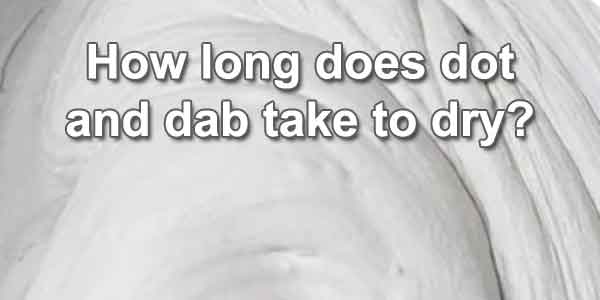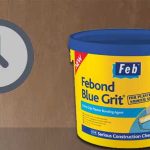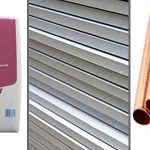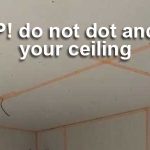Dot and dab is a popular way of attaching plasterboard to solid walls. The reason it’s popular, is mainly due to its ease of installation. Also, once fixed it gives a strong flat surface to work on.
The drywall adhesive used for dot and dab, comes in a premixed powder, which is mixed with water. This is pretty simple and can be done in a couple of minutes with a bucket and mixer.

Following this, adhesive can be added to the wall spaced roughly 300mm to the centre of each dab vertically. This is usually applied in 3 rows on a standard 1200x2400mm board. The dabs themselves should be roughly 50mm wide and around 250mm long.
Once you have applied the adhesive, you are ready to stick your board back onto the wall. At this point the dabs are wet, meaning the board can be manipulated with a straight edge and checked with a level, in order to achieve a flat, plumb surface.
As you can see, the process of adding a board using this method is pretty easy. From start to finish, installing your first board should only take around 10-15 minutes.
Once your board is attached, you will need to wait for the adhesive to dry before you can plaster the surface.
The drying process for dot and dab takes around 3-4 hours. This duration can increase slightly in colder conditions. However, there is a chemical reaction happening in the adhesive. This alone is creating heat and causing the dabs to set.
Once the adhesive is dry, it sets extremely hard. Providing you prepped the surface well before hand, the bond to the sub surface should be very strong. At this point your boards are ready for skimming.
How thick should dabs be and will it affect drying time
As a general rule, dabs should be somewhere between 10-25mm once the board is secured. The advantage of using an adhesive like this, is it helps you flatten out uneven surfaces.
If you are fixing to an uneven surface, this will usually mean you require thicker dabs, in order to account for discrepancies in the wall. Thicker dabs means more adhesive and this can potentially mean longer drying times. However, the difference isn’t going to be significant.
There are several factors that will affect drying time. The biggest is usually going to be temperature. If you were installing thick drywall adhesive on a cold wet day, this would obviously be the worst-case scenario, and would mean longer drying times. In this situation, heating the area is advisable to aid the drying time.
Alternatives to dot and dab
Dot and dab is a relatively easy, and cost-effective way of creating nice, flat walls for plastering. However, it is not your only option.
Backing plaster
There are several different types of backing plaster that can be applied to solid walls. Some of the most common, are bonding and hardwall. Generally, these will go off within 1.5 to 2 hours. So they do dry faster than drywall adhesive. Also, the cost will usually be lower as you don’t need to pay for boards.
However, applying a decent backing coat is a more technical job compared with dot and dab. If you don’t have the required skills, this may be a more complicated option.
Timber battens
Another option is to add timber batons to the wall and board. As a joiner by trade, I may be slightly biased here, but this is usually my preferred method, and this is for several reasons.
- Firstly, you are able to create a completely flat surface for the boards to fix too. The frame is plum and flat before you start. In comparison, you actually level the board with dot and dab. Then once it is set you are unable to make any adjustments (if needed).
- The time it takes will depend on the surface. For a relatively flat surface, batons could be fixed at 400 centres quite quickly. The caveat to this, would be very uneven walls. In this case dot and dab could be the faster, easier option.
- The batons and boards are attached with mechanical fixings. If you prep properly and do a good job, your drywall adhesive shouldn’t fail. However, it does happen if the suction to the surface is not good, dabs can easily pop off the wall. Batons on the other hand, are screwed to the wall, and plasterboards are screwed to the battens. This is going nowhere.
Are either option faster than dot and dab?
In reality, whichever method you choose, the time frame it takes between getting started, and skimming the final surface won’t be that much different.
As we already mentioned, the drying time for dot and dab is roughly 3-4 hours. You can add a little more time for mixing and installing the boards, but this is not massively time consuming. The process is relatively simple and once you get into a nice flow, dabbing boards can be done pretty quickly.
Alternatively, if you decide to use a backing plaster prior to skimming, the drying time is less than that of drywall adhesive. However, the application time is longer. Therefore, the time frame from start to finish will actually be quite similar.
When it comes to installing timber battens, there is obviously no drying time to consider. But the additional fixing of timber, as well as cutting, drilling, and filling screw holes all make the installation process longer.
As a result, you will probably find timber battens also take a similar amount of time before you can start finishing the boards with plaster.
The faster and more suitable approach, will usually depend on the individual circumstances of the job. One is not necessarily better than the other. The option you choose will depend on your own skill level and also the specifics of the job.
Conclusion
Dot and dab takes around 3-4 hours to dry. The time it takes can be affected slightly by things like weather, temperature, and humidity. However, it is a chemical reaction, so once it is mixed with water, the adhesive will go off at a fairly similar rate regardless.
Due to ease of application and relatively quick drying time, dot and dab is a popular option for boarding walls prior to skimming, but it isn’t your only option. There are other methods that will give a similar finished result, that may be better in some instances.




